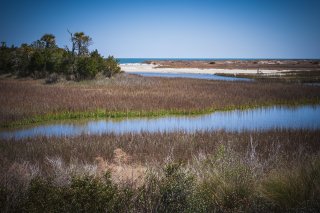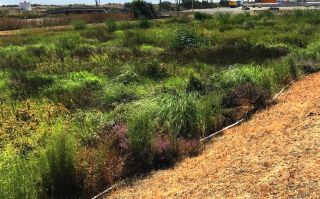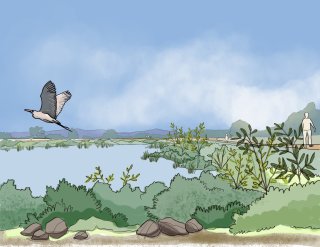Water Reuse and Nature-based Solutions
This page provides information for water managers about how nature-based solutions can be used for water reuse projects, their multiple benefits, and successful project examples.
On this page:
- Why use a nature-based solution for water reuse?
- Examples of water reuse projects that use nature-based solutions
- Benefits of nature-based solutions in water reuse projects
- Other relevant EPA programs
Why use a nature-based solution for water reuse?
The term "nature-based solutions" describes actions that protect, conserve, restore and sustainably manage natural or modified ecosystems. They use natural features or processes to address public health and environmental challenges while providing multiple benefits to people and nature. Although most water treatment and reuse projects use conventional water infrastructure, such as sewers and treatment plants, they may also incorporate nature-based solutions, such as treatment wetlands, into their design. Nature-based solutions can be attractive to utilities interested in water reuse because of the multiple benefits they can provide to communities, including improved water quality, habitat restoration and recreational opportunities.
Recycled water as a water source for nature-based solutions
Treated municipal wastewater and captured stormwater can be reused to create and maintain nature-based solutions that require a steady source of water.
For example, recycled water can:
- Supply irrigation water to trees growing in an urban park, which cool cities in the summer.
- Provide a freshwater source to native plants growing in coastal wetlands that were purposely designed to buffer communities from storm surges.
- Supply water to restore aquatic ecosystems or create vegetated nature-based solutions, particularly in many parts of the arid southwestern United States.
Nature-based solutions can be part of a water reuse treatment train
Water managers have used nature-based solutions to capture, treat, or store wastewater or stormwater as part of their water reuse projects.
Some examples include:
- Aquifer recharge with recycled water: after properly treating wastewater or stormwater, some municipalities may strategically infiltrate the treated recycled water into aquifers. This practice can ensure groundwater levels remain stable, may improve the quality of the recycled water, and stores the recycled water for later use.
- Building treatment wetlands: treatment wetlands (also referred to as constructed wetlands) use the natural physical, chemical, and biological properties of wetland vegetation, soil and microbial communities to treat the water flowing through them. Wastewater or stormwater that has been adequately treated in a treatment wetland can be reused for other purposes.
- Promoting the use of rain gardens, bioretention systems, and other infiltration practices: infiltration practices that capture rainwater and stormwater can increase water supply for water reuse. This also helps slow down and treat stormwater to prevent erosion and protect water quality in lakes and streams.
Examples of water reuse projects that use nature-based solutions
This section provides real world examples of how nature-based solutions are being used or researched in water reuse projects. Each example project details how the nature-based solution provided benefits such as water treatment, storage, or public access to outdoor space.
Water treatment and storage prior to potable reuse
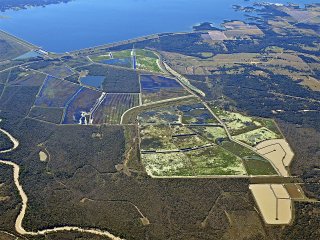
During potable water reuse, water managers often direct recycled water through an environmental buffer, such as a wetland, that is typically built upstream of a drinking water treatment plant. Treatment wetlands that are built as environmental buffers are nature-based solutions that employ natural water treatment mechanisms to improve water quality and provide other benefits such as water storage and habitat creation.
The George W. Shannon water reuse project in North Central Texas uses constructed wetlands to improve water quality prior to potable reuse. These wetlands remove many contaminants from the water and form a large recreational park for the community.
Stormwater capture, treatment, and aquifer recharge
Cities across the United States are looking for ways to capture and reuse stormwater to prevent flooding during rain events, and some are looking to supplement their drinking water supplies. Aquifer recharge involves infiltrating water into the ground for storage and possibly for reuse. Green infrastructure practices that use soil and plants as a treatment system, are a type of nature-based solution that can help remove contaminants from stormwater during infiltration. These infiltration sites can double as amenities for parks to provide recreational benefits. More examples of green infrastructure are found on EPA’s Green Infrastructure website.

The Hollenbeck Park Lake Rehabilitation Project in East Los Angeles, CA will create a park containing constructed wetlands, a restored lake and infiltration wells to capture, treat, and infiltrate stormwater into the local groundwater supplies. More information about the project can be found on LA Sanitation and Environment's website.
Treatment of reverse osmosis concentrate
Reverse osmosis is often used by utilities as an advanced water treatment step to purify water prior to potable reuse. However, because reverse osmosis concentrate —the liquid waste product generated during this treatment step— contains high levels of regulated contaminants, treatment and disposal can be very costly for utilities especially in inland locations and research is needed to understand how to reduce the cost of disposal .
Researchers have identified constructed wetlands as a potential low-cost way to remove multiple contaminants from reverse osmosis concentrate prior to disposal. For example, researchers are evaluating the treatment of reverse osmosis concentrate in one kind of constructed wetland called a horizontal levee in the San Francisco Bay Area. As water passes through constructed wetlands a range of physical, chemical, and biological processes can improve water quality by removing nutrients, organic contaminants, and trace metals from the water being treated.
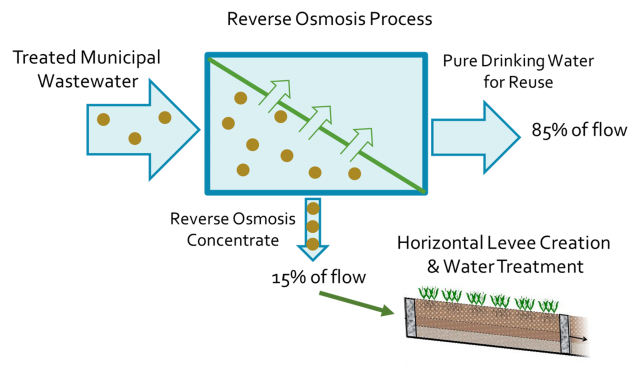
Benefits of nature-based solutions in water reuse projects
Certain types of nature-based solutions can make it easier to implement a water reuse project because they can lower the cost and enhance multiple benefits of a water reuse project. This section describes some of the benefits of including nature-based solutions in a water reuse project.
Lower the cost of water reuse: A treatment wetland is a nature-based solution that can help lower the cost of treating water for reuse because they often require less energy, chemicals, and maintenance to remove contaminants from water than other treatment technologies.
Gain support for water infrastructure investment: Habitat restoration and recreation are two benefits that nature-based solutions can provide and are highly valued by many communities. The Fairfield-Suisun Sewer District gained support from their local communities for water reuse and other water infrastructure projects by integrating nature-based solutions into their plans.
Improve climate resilience through flood protection and sea level rise adaptation: Reused water can be a source of freshwater for creating new coastal wetlands, some of which may not exist without the presence of reused water. These wetlands can protect water infrastructure from flooding and sea level rise, which are projected to increase with climate change. Nature-based solutions may cost less than conventional options, such as levees, rip rap and sea walls.
Manage stormwater and urban flooding: Green infrastructure practices, such as bioretention systems, that provide infiltration for later reuse can also help slow the flow of stormwater, which reduces urban flooding. Green infrastructure also delivers multiple environmental, social, and economic benefits.
Other relevant EPA programs
- The Green Infrastructure program provides tools, funding opportunities, technical assistance, and other resources to help communities bolster their capacity to manage stormwater. By installing green infrastructure, communities can become more resilient and achieve environmental, social, and economic benefits.
- The Green Infrastructure Federal Collaborative has compiled federal funding resources for green infrastructure and nature-based solutions.
- The Nonpoint Source Pollution Branch provides funding, data, and other resources to address nonpoint source pollution using nature-based solutions.
- The National Estuary Program is a collaborative, efficient, and adaptable ecosystem-based network of organizations that protects and restores 28 estuaries of national significance. Nature-based solutions are being integrated into estuary management plans and funded through the Bipartisan Infrastructure Law.
- EnviroAtlas provides information and geospatial data about ecosystem services – the benefits that people receive from nature – as well as mapping tools to support decision makers and researchers.
- The Creating Resilient Water Utilities initiative provides drinking water, wastewater, and stormwater (water sector) utilities with practical tools, training, and technical assistance needed to increase resilience to climate change. They assist water sector utilities and stakeholders by promoting a clear understanding of climate change and help to identify potential long-term adaptation options for decision-making related to implementation and infrastructure financing.
- The Climate Ready Estuaries program works with the coastal management community to assess climate change vulnerabilities; develop and implement adaptation strategies; and engage and educate stakeholders. The program provides technical guidance and assistance about climate change adaptation.
- The Constructed Wetlands webpage provides information about the design and operation of wetlands built for water treatment.

